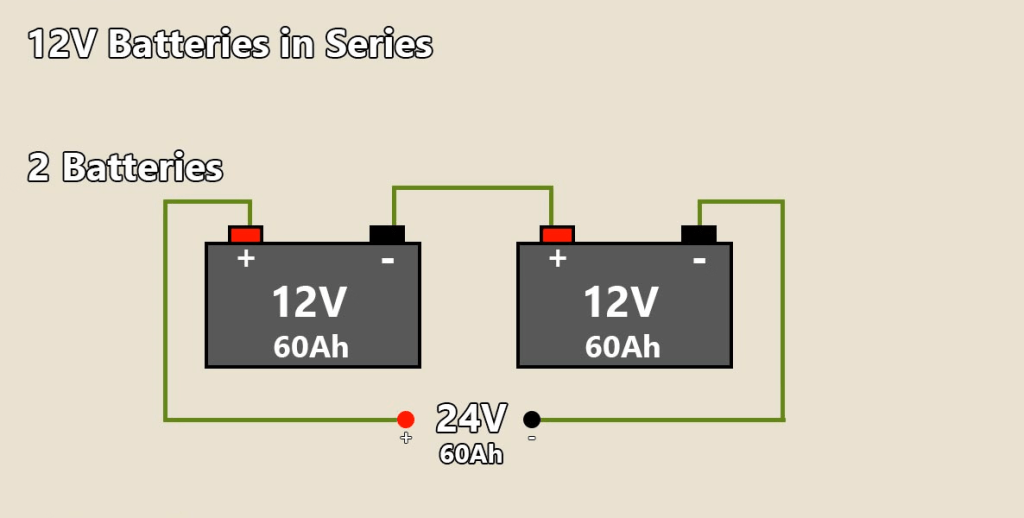Batteries have been a common companion of our life since its inception. From remote-controlled cars to real electric cars or RV fishing boats, batteries are almost everywhere nowadays. Though, the voltage of the battery never was a concern before. Because in earlier days, batteries had fixed charging voltage which was high enough to force amps into the battery. But now, in some cases like while working with DC power systems for boats or off grid applications, a serious decision is required. Most people go with two 12v units because 24v runs at a higher voltage than standard residential electrical systems, providing boosted power for multiple services. To ensure the longevity and efficiency of the battery system, it’s important to charge it correctly, which means more than just plugging the charger in.
Understanding a 24V System
A 24v system means an electrical battery system that has a voltage capacity of 24 and such systems can handle powerful electrical devices or motors that require 24 volts of electrical power. There are various use of 24v systems, like –
- Industrial Equipment: certain heavy-duty commercial instruments like forklift, heavy machinery and a range of agricultural tools requires a 24V power system to run the tool.
- Automotive: Some vehicles, especially commercial trucks and larger recreational vehicles (RVs) require a 24v system instead of a 12v system which is found in most passenger cars.
- Marine and RV application: Marne vessels and RVs often run on 24v systems for their electrical needs, including powering applications, appliances, lighting, and other onboard equipment.
- Off-grid solar power: Off-grid solar power systems which are used in remote locations or areas without access to the traditional power grid, often employ 24v systems. These systems typically consist of solar panels, charge controllers, batteries, and inverters to convert and store solar energy for use in powering appliances and devices.
In a 24V system, it is important to ensure that all components and devices are compatible with the voltage requirements. This includes selecting batteries, chargers, and other equipment specifically designed for 24V operation to ensure proper functionality and avoid potential damage or safety hazards.
How To Charge A 24v System?
When you connect two 12-volt batteries in series, their voltages combine to generate the overall voltage of the battery pack. This differs from parallel connections where the capacities add up while the voltage of the battery pack stays the same.
Many people have questioned whether a 24v battery can be charged with a 12v charger. In fact, two 12v batteries are combined to form a 24v battery. So, a battery can be charged but at a time.
When it comes to charging this particular system, you have multiple options available. The choice of charging method will depend on the specific arrangement of your batteries and the charger you have on hand. The tools that you need to charge your 24v system are –
- Two 12-volt battery chargers OR a 24-volt battery charger
- Jumper cables
- Blue wire
- Green wire

Two 12v Batteries In Series With Two 12v Chargers
When it comes to charging a 12v battery, there are a few important factors to consider. First, 12v chargers typically have low milliamp outputs ranging from 100 to 500, with capacities of up to 90 amps. These chargers can be conveniently plugged into standard 115v outlets, although it’s worth noting that chargers delivering 65 amps or more might require a 20 amp circuit for optimal performance.
To select the right charger for your battery, experts recommend choosing one that is approximately 25% of the battery amp-hour (ah) 12v battery, a 25 amp 12v charger would be suitable.
In the case of a 24v system, it is advisable to use two 12v chargers. This method ensures that two 12v trolling motor batteries receive a full and balanced charge, while also preventing the discharge problems associated with battery cycling.
Here’s a step-by-step guide on how to use two 12v chargers effectively:
- On the positive terminal of one battery, connect the red jumper cable of the first charger.
- Now, connect the black cable of the first charger to the negative terminal of the same battery.
- Then, again connect the red jumper cable of the 2nd charger on the 2nd battery.
- Lastly, connect the black cable of the second charger to the negative terminal of the second battery.
By following these steps, you can ensure a proper and efficient charging process for your 24-volt system, allowing both batteries to receive a thorough charge without encountering any discharge-related issues.
Two 12v Batteries In Series With One 24v Charger
There is a simpler approach than for charging your two 12v batteries. You can easily avoid the hassle of using 2 distinct chargers and opt for a single 24v charger to charge your two 12 batteries. Using a single 24v charger offers more power and helps minimize voltage drops, but keep in mind that requires a higher power input. To charge your two 12v batteries with one 24v charger follow the steps below –
- Take the red cable of the charger and connect it to the positive terminal of the first battery.
- Attach the black cable of the charger to the negative terminal of the second battery.
By following these instructions, you can utilize a 24-volt charger to efficiently power up your 24-volt battery series.
However, you can connect four 6-volt batteries together in parallel or series circuit connection to make a 24-volt battery and charge it with either two 12-volt chargers or a 24-volt charger. But it is better not to do this as this method is not universally accepted.
Charging Time
Calculating the recharging time for your battery system is a straightforward process. Simply divide the amp hours that need to be replenished by 90% of the charger’s rated output. Let’s take an example to illustrate this. Suppose you have a 100 amp hour battery that is discharged by 10%, meaning it requires a replacement of 10 amps. If you are using a 5 amp, 12-volt charger, the formula to determine the recharging time is as follows: 10 amp hours / (0.9 × 5) amps. By applying this formula, you will find that it will take approximately 2.22 hours to fully recharge your battery system.
How To Charge a 24v Battery with a 12v Solar Panel?
You can charge a 24v battery with a 12v solar panel, but you’ll be needing a solar charge controller for that. Nowadays they are becoming quite popular as many people use 12v or 24v now for trucks, trolling motors, etc. However, make sure that you make the system waterproof if you are using it on a boat. In case of wet weather, sea salt and UV rays, can damage the controller. For remote location scouting, a solar charging system is a great way to back up your battery.
Wrapping Up
To charge a 24v battery system, you can use either two 12 or single 24-volt chargers. Connecting those depends on series or series/parallel but generally, red cable goes to positive terminals, and the black one goes to negative terminals. However, depending on the manufacturers, there might be blue or green wires, check the instruction manual for perfect setup.










Leave a Comment